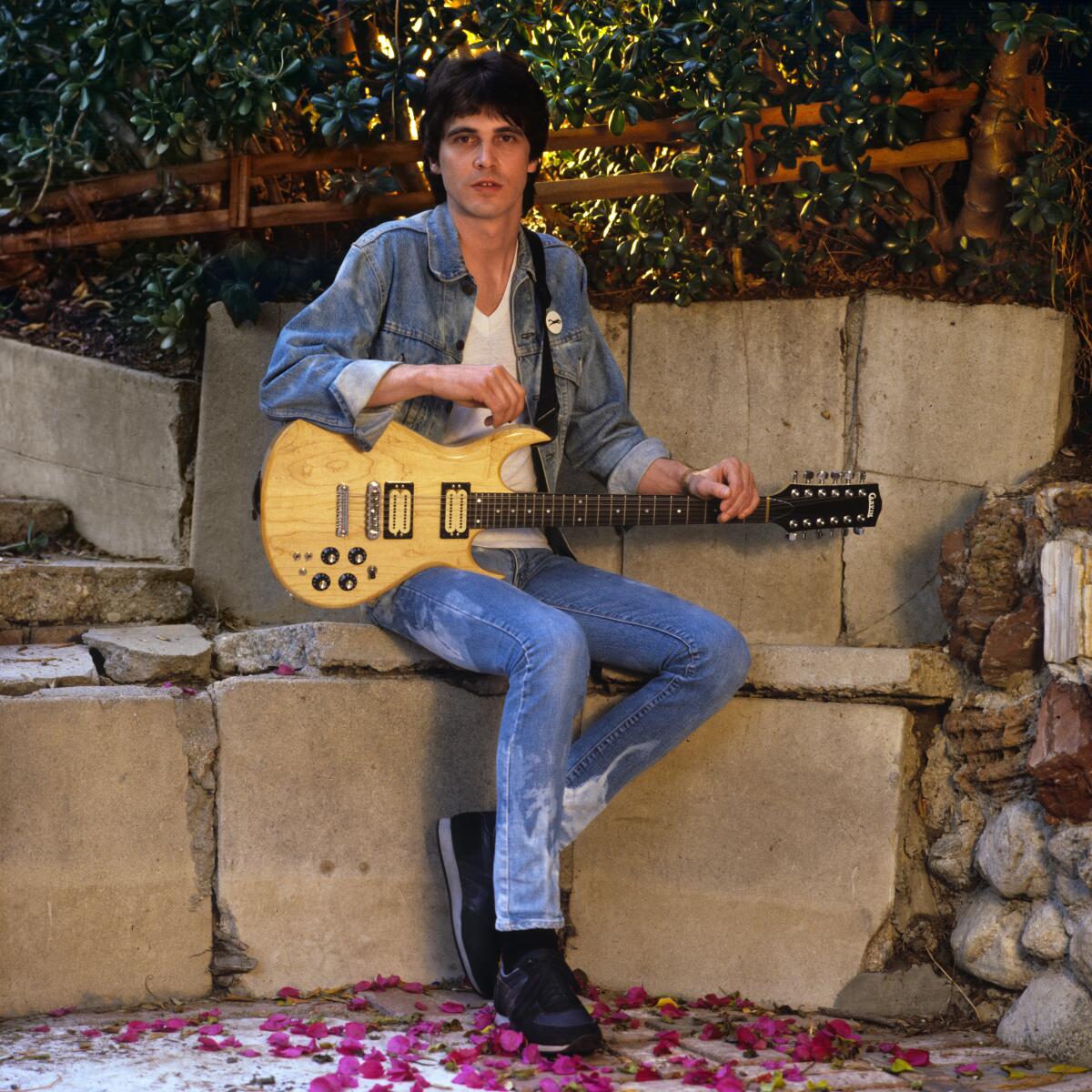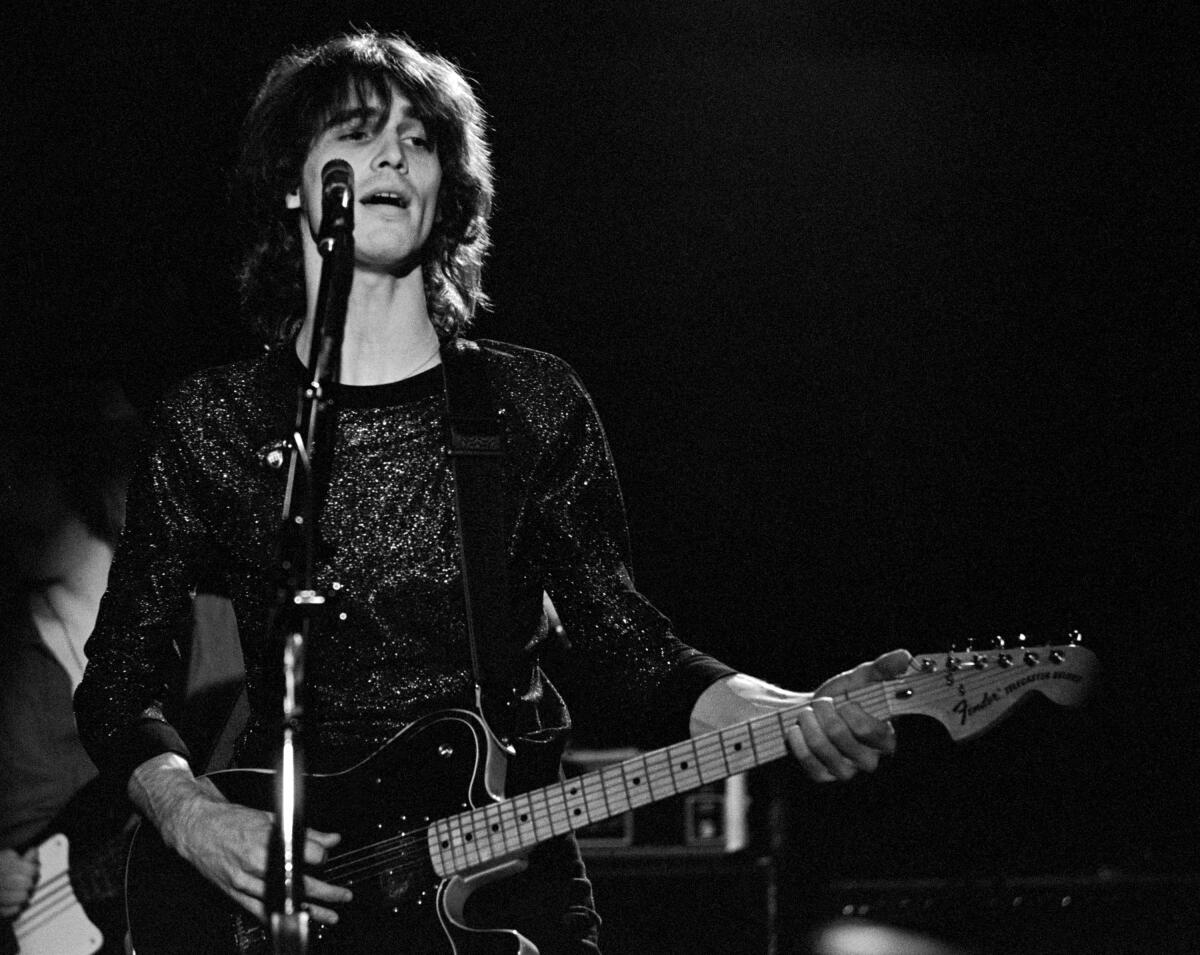Dwight Twilley, power-pop pioneer, dies at 72

- Share via
Dwight Twilley, one of the musicians who pioneered the rock subgenre known as power pop, died on Wednesday. He was 72.
His death was confirmed by the Church Studio in Tulsa, Okla., where Twilley recorded many of his best-known songs, including his signature hit, “I’m on Fire.” The Facebook announcement read, “He peacefully departed this world, surrounded by the love of his life, Jan, and close friends ... Dwight’s musical prowess touched countless lives, leaving an indelible mark on the hearts of many. We are profoundly thankful for the enduring musical legacy he has bestowed upon us all.”
According to his hometown newspaper Tulsa World, Twilley suffered a stroke Saturday while driving and crashed his vehicle into a tree. He died at a hospital four days later.
A lifelong disciple of the Beatles who also harbored an enduring love for Elvis Presley, Twilley devoted his career to hooks, harmonies and ringing guitars, a combination designed to evoke the platonic ideal of a hit pop single. Twilley achieved one of those with “I’m on Fire,” the debut single from the Dwight Twilley Band, a group he co-led with his old friend Phil Seymour, which shot into the Top 20 upon its release in 1975.

With its accompanying album “Sincerely” garnering positive reviews, including a rave from Rolling Stone, the Dwight Twilley Band seemed poised to follow a similar trajectory to Tom Petty and the Heartbreakers, label mates at Leon Russell’s Shelter Records and kindred spirits who also updated the jangle of 1960s garage rock for the slicker 1970s. But sucked into the vortex of the collapse of Shelter Records, the band couldn’t capitalize on “I’m on Fire,” leading to internal tensions that ultimately led Seymour to leave Twilley behind.
On his own, Twilley did earn a second chart hit in 1984 with the insistent “Girls,” but he ultimately embraced his role as a cult act. In Tulsa, he opened his own studio and launched his own record label, spending the last half of his life releasing collections of bright, effervescent tunes that adhered to the artistic standards he initially essayed with “Sincerely.” Occasionally, one of his old songs surfaced in unexpected places — “Looking for the Magic” sounded effectively ominous in the 2011 horror film “You’re Next” — but Twilley largely played to a cult audience who shared his passion for immaculately crafted pop-rock.

Born in Tulsa on June 6, 1951, Dwight Twilley displayed an affection for the arts before witnessing the Beatles play on “The Ed Sullivan Show” in 1964, but that particular performance inspired him to form a group called the Intruders when he was in middle school. The Beatles were also the catalyst for his introduction to Seymour. The pair both attended a matinee of “A Hard Day’s Night” in 1967, a screening intended for children. Twilley remembered, “If you brought a kid with you, you got in for free. I brought my little brother, and Phil brought somebody. So, it’s like, here’s this line of little tiny toddlers and there’s only two people that are tall enough to pass through the turnstile.” Once the film was finished, the pair headed over to Twilley’s house, where they immediately started writing and recording songs together.
Initially, Twilley and Seymour called themselves Oister, splitting the lead vocal duties on originals written by Twilley. Working in Twilley’s garage and Seymour’s bedroom, they finished an album, pressing acetates of “Oister Presents Swirling Clouds,” but they soon felt limited in Tulsa. Lacking the funds to move to either coast, the pair headed to Memphis in 1969, walking through the doors of Sun Records without realizing it was the label that gave Elvis Presley, Johnny Cash, Jerry Lee Lewis and Carl Perkins their starts. Jerry Phillips, the son of Sun founder Sam Phillips, pointed the duo in the direction of Ray Harris, one of its old signings who was then one of the owners of Hi Records. Harris introduced Twilley and Seymour to rockabilly, igniting a love of Presley within Twilley that helped give his pop a leaner, harder-edged sound.
Russell’s debut album exorcised the childhood trauma inflicted by her adoptive father. On her new LP, the queer Americana artist maps a funky path forward.
Returning to Tulsa, the pair brought guitarist Bill Pitcock IV into the fold. Late in 1974, Oister headed to Los Angeles where the band wound up signing with Shelter, the imprint run by Russell and Denny Cordell that was based in Tulsa. Shelter insisted the group change its name to the Dwight Twilley Band, a move that suggested Seymour was a hired hand, then brought the band members back to Tulsa, setting them up at the label’s studio in a renovated church. The band promptly cut “I’m on Fire,” a song that blended their love of Beatles harmony with a rockabilly swagger.
Released early in 1975, “I’m on Fire” climbed its way onto the Billboard singles chart, but the Dwight Twilley Band wasn’t able to ride this momentum because of the implosion of Shelter after a falling out between Russell and Cordell. Cordell told Twilley to keep recording, so the group amassed a surplus of material for its debut album, “Sincerely,” which appeared a year after “I’m on Fire.”

“Sincerely” arrived too late to capitalize on “I’m on Fire,” so the group rushed out a second album, “Twilley Don’t Mind,” in 1977. At that point, there was a nascent roots-rock revival coalescing around the Dwight Twilley Band and Petty and the Heartbreakers. Twilley and Seymour both sang on Petty’s eponymous 1976 debut, with Petty returning the favor by playing guitar on “Looking for the Magic” on “Twilley Don’t Mind.” Where the Heartbreakers wound up weathering Shelter’s collapse, the Dwight Twilley Band split months after the release of its second album.
Twilley soldiered on as a solo act, hiring producer Noah Shark, who helmed Petty’s “You’re Gonna Get It” LP, for “Twilley,” a well-crafted 1979 album that steered the singer-songwriter toward the middle of the road. It took three more years for Twilley to release “Scuba Divers,” a record that didn’t attract much radio attention, but a vocal assist from Petty on “Girls” helped in 1984, as did a video that nodded to the locker-room fantasies of the hit teenage comedy “Porky’s.”

“Girls” gave Twilley his final hit single, peaking at No. 16, the same position “I’m on Fire” reached a decade earlier. After “Wild Dogs” in 1986, he left major labels behind, but Twilley wasn’t forgotten. His ballad “Why You Wanna Break My Heart” appeared as Tia Carrere’s show-stopping moment in “Wayne’s World” in 1992. He had his catalog reissued during the CD boom of the 1990s, including “The Great Lost Twilley Album,” a collection filled with material Twilley and Seymour recorded in the mid-1970s.
Toward the end of the 1990s, Twilley started releasing home recordings he made over the years. He’d punctuate collections of rarities with records concentrating on a particular theme — he put out a Beatles tribute album in 2009 — and he compiled highlights of these efforts on “The Best of Dwight Twilley: The Tulsa Years, 1999-2016, Vol. 1,” a collection released digitally in 2023.
Twilley is survived by his wife, Jan, and his daughter Dionne.
More to Read
The biggest entertainment stories
Get our big stories about Hollywood, film, television, music, arts, culture and more right in your inbox as soon as they publish.
You may occasionally receive promotional content from the Los Angeles Times.










